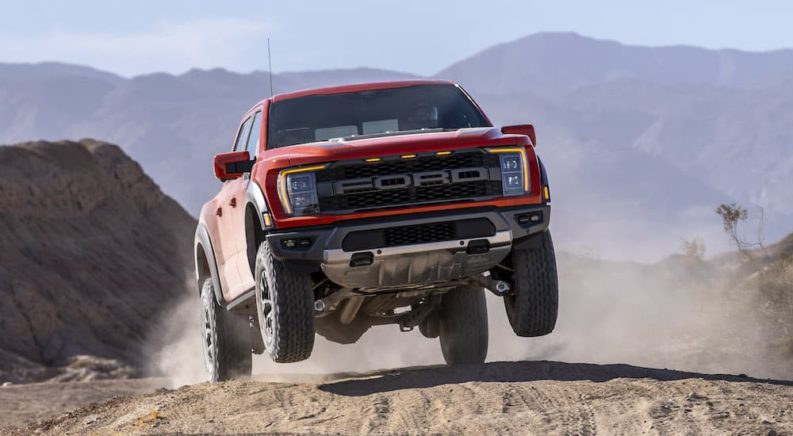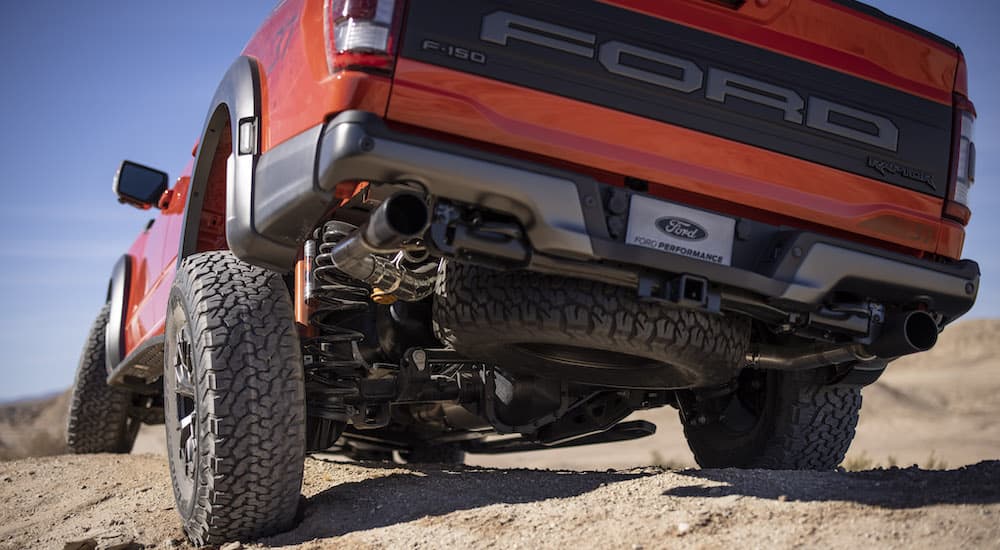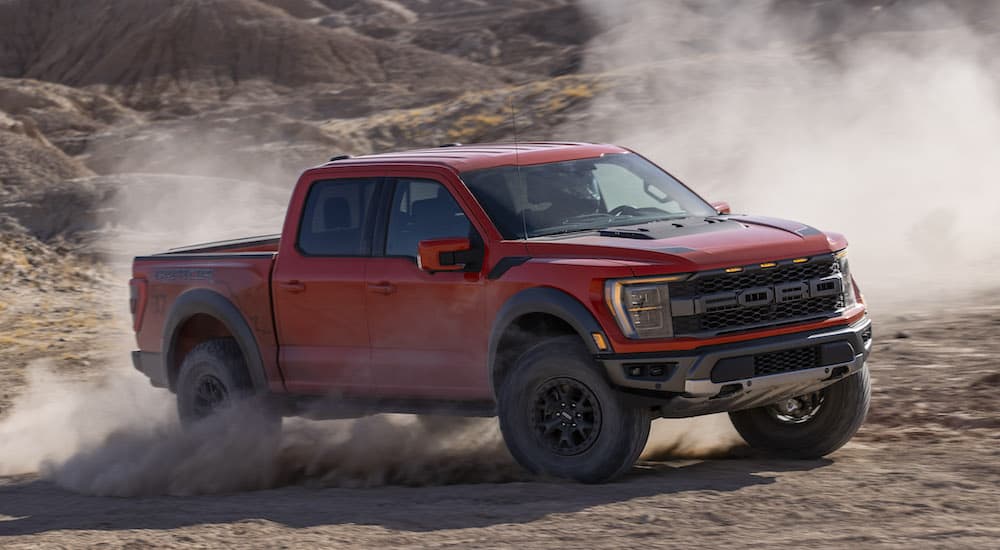A lot has been made of the 2022 Ford F-150 Raptor’s power, and for a good reason. The veritable off-road beast is one of the most powerful pickups on the market, with a massive twin-turbo V6 that wouldn’t be out of place in the desert racing circuits that gave birth to this breed of off-road trophy truck. The situation is poised to become even more ridiculous in 2023 as Ford announces plans for an even more powerful Raptor R trim, which will lift the V8 from the Mustang Shelby GT500 to increase the horsepower to a ridiculous 700.
That sort of power is becoming the norm in the high-end performance truck category, allowing drivers to take on daunting off-road challenges with ease. That’s all well and good, but for the uninitiated, it can make it a little too easy to get yourself into some sticky situations. With great power comes the potential for greater damage, but luckily that’s where the suspension comes in. Able to absorb all the bumps, dips, and jarring shocks you can throw at it, a robust suspension should be at the top of the list for any drivers looking to test their vehicle’s off-road prowess.
Of course, the same characteristics that allow a truck’s suspension to excel in off-road environs might not translate well to everyday driving. These heavy-duty upgrades can come back to bite it when you’re dealing with paved surfaces, which, according to some estimates, is where off-road vehicles spend up to 90 percent of their time. When it comes to the 2022 F-150 Raptor, Ford has done an admirable job of engineering around this problem, delivering a pickup with a remarkably smooth ride that belies its 5,740-pound heft. This is made possible in large part thanks to the use of the truck’s unique long-travel suspension, which excels in both on and off-road scenarios. But just what is a long travel suspension, and how does it differ from the stock suspension found on many of the Raptor’s pickup rivals? Let’s take a deep dive and see why this long-travel approach can make such a difference when you’re navigating the road less traveled.
Building A Better Suspension
It wasn’t that long ago that off-roaders were limited to mechanically-inclined 4×4 owners willing to put in a lot of D.I.Y. work to transform stock pickups into off-road contenders. Now trucks like the F-150 Raptor are opening up the world of off-roading to an entirely new continent of thrill-seeking drivers, making it easier than ever to dive into the thrilling hobby but also presenting some new challenges for those not as well versed in off-road construction.
While aftermarket additions like lift kits might increase ride height and reduce the likelihood of bottoming out after a particularly ambitious jump, they don’t actually change the geometry of a given suspension. For this, you’ll need to look at long-travel suspensions. Long-travel suspensions are great at absorbing the shocks that follow such feats of off-road bravery, which is particularly important in the case of a powerful pickup like the 2022 Raptor. Long-travel suspensions also increase suspension articulation, allowing the tires to grip the road surface better and improving the most important attribute in any off-road situation: traction.
When navigating challenging off-road terrain, it’s all about wheel travel. For those new to the sport, wheel travel refers to how far a wheel can move vertically before bottoming out, which, as you can imagine, comes in handy when the road ahead is paved with rocks, trees, and other immovable obstacles. Increasing your off-roader’s wheel travel not only means it’ll be better able to weather these types of shocks but also help to improve suspension articulation and traction by ensuring the tires can easily make contact with the road.
When building an off-roader from the ground up, drivers often start with things like larger tires and lift kits. These aftermarket components can go a long way in improving a 4×4’s ground clearance, giving drivers the confidence to traverse off-road terrain without worrying about bottoming out when climbing over rocks or going full-send on a particularly tempting incline, but they have their limits. This is where long-travel suspensions come in, offering some distinct off-roading advantages that can’t be accomplished through the use of lift kits and larger tires. Converting a vehicle over to a long-travel suspension can be quite the undertaking, requiring no shortage of specialty tools, mechanical know-how, and a few days off from work, but luckily when it comes to the 2022 F-150 Raptor, Ford has already done all the heavy lifting. The automaker has been steadily improving the Raptor’s suspension over the years, bringing the rugged pickup closer and closer to perfection with every new model.
“Each generation of Raptor, we generally increase the suspension travel, increase the capability of the shock absorbers, and increase the performance of the tires,” said Ford Performance supervisor Jack Cooper in an interview with Road & Track. “We figured out pretty quickly this was the best answer for the truck, to get all the travel we need and better use the torque. The great thing for us is this is a Raptor specific design, it’s not compromised by sharing with something else.”
Breaking It Down
Composed of a number of parts, including bump stops, coil-over shocks, and upper and lower control arms, the components that make up a long-travel suspension aren’t always that much different from the stock suspensions that can be found on many of the light-duty trucks currently on the market. The difference comes down to how rugged these components are, with long-travel suspensions opting to use some of the most heavy-duty parts available on the market. These include:
Longer upper and lower control arms
Control arms connect a truck’s front wheel assemblies to its frame. As the name would suggest, they’re responsible for helping to steer the vehicle, angling the tires down to the road, and guiding the wheel’s up-and-down movement. On vehicles with long-travel suspensions, these control arms extend further out than normal, giving the tires as much as six extra inches of reach per side. This allows for more wheel travel and widens the vehicle’s footprint, making for a more stable ride. Vehicles equipped with long-travel suspensions also usually feature longer front constant velocity axles, which allow for an even wide stance.
Longer coilover shocks absorbers
Most vehicles use shock absorbers or struts to help smooth the ride, but coilover shocks offer the best of both worlds. A coilover is basically just a shock with a spring that wraps around it and, unlike regular struts, can be adjusted. This comes in especially handy in off-roading, where drivers might want to fine-tune their suspension to tackle a wider variety of terrain and adjust for ride height, spring rate, dampening, and more. The 2022 F-150 Raptor features a new 24-inch, five-link rear coil suspension, first introduced in 2021. Exclusive to the Raptor, this five-link suspension marks a significant upgrade over the leaf spring found on many other F-series pickups and gives the pickup as much as 14 inches of wheel travel. The coilover suspension is paired with Fox internal-bypass shocks, which, at 3.1 inches in diameter, are the largest ever used on a Raptor pickup.
Bump Stops
Bottoming out is always a real danger when it comes to off-roading, even on a vehicle with an enhanced suspension like the 2022 F-150 Raptor. That’s where bump stops come in. These components are designed to cushion the shocks should they bottom out, preventing the type of metal-on-metal contact that can cause serious damage to the chassis, suspension, or shock absorbers themselves.
Limit Straps
Limit straps are basically the opposite of bump stops, serving a similar role but focusing more on overextension rather than bottoming out. When a vehicle is in the air, its “unsprung” weight can cause serious damage to the shocks and other drivetrain components. Limit straps prevent a suspension from fully extending when the vehicle leaves the ground and can also prevent damage to the constant velocity (CV) joints.
Extended Fenders
Pushing an off-roader’s wheels a little further from the center of the vehicle might work wonders when it comes to traction and articulation, but it can also cause them to fling up a lot of dirt and rocks in the process. Normally this debris would be safely shielded by the truck’s wheel wells, but this often isn’t the case when it comes to many off-road vehicles. Extending the fenders goes a long way in cutting down on flying rocks and dirt, which have the potential to crack windshields, injure bystanders, and just generally wreak havoc.
A Worthy Investment If You Plan On Spending Time Off the Payment
Whether you’re looking to get behind the wheel of a 2022 Ford F-150 Raptor or build your own off-road rig from the ground up, a long-travel suspension offers a lot of advantages for those in the know. This rugged setup is better able to withstand the abuse that can come with regular off-road use, giving drivers a little more wiggle room when it comes to tackling those alluring obstacles that can define an off-road excursion.
Shock absorbers play a major role in any off-road vehicle, and while the 2022 F-150 Raptor has that angle well-covered with its robust design, they’re just one part of the recipe. Those looking to get into the off-roading world might want to start with some simpler modifications, such as installing a lift kit, but for those looking for a ready-made off-road monster, you could do a lot worse than the F-150 Raptor. The pickup gives Ford the perfect outlet to showcase the latest and greatest in off-road technology, and the 2022 model’s impressive long-travel suspension is just the most recent chapter in the brand’s ongoing off-road legacy.






